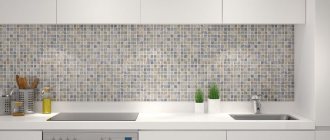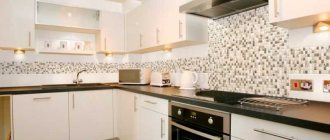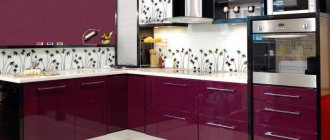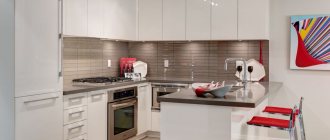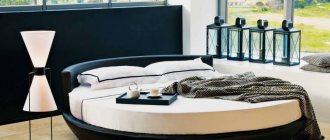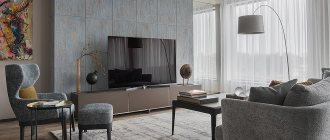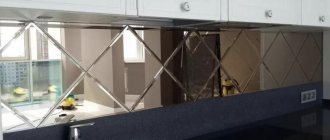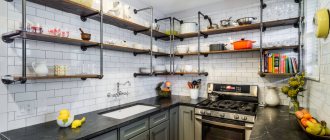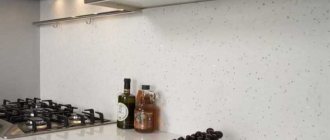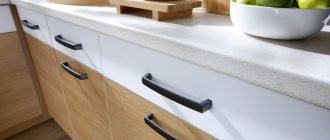<
>
The kitchen is the room where residents spend the most time. They not only cook food there, but also host dinner parties, receive guests, and simply relax over meals with family. It is very important that the kitchen always remains neat and cozy.
To maintain cleanliness, special finishing options are used for working and adjacent surfaces, one of which is the kitchen apron.
Kitchen apron – what is it? Functions
The section of the wall between the upper and floor elements of the headset is constantly exposed to aggressive influences - temperature changes, splashes of water, oil and grease.
A kitchen apron is a structure made of special panels designed to protect the part of the wall located above the work area from dirt and damage.
In addition to being protective, it also performs a decorative function - with its help you can diversify the interior of your kitchen unit, making even the most ordinary set of furniture bright and stylish.
What is an apron for?
The space of any kitchen is divided into two main zones - dining and working. At the usual table we have breakfast and dinner, drink evening tea and talk with relatives and guests. But of course, the main element of the kitchen remains the work area - where food is directly prepared. Sink, stove, spacious countertop - usually they are located next to each other on the same line, close to the wall.
It is impossible to prepare food while maintaining absolute “sterility” in the kitchen. Splashes of water, flying droplets of juice from vegetables and fruits, small particles of food, fumes from pots and pans - all this flies daily onto the wall adjacent to the kitchen work area. Even thorough cleaning after each cooking does not save the situation - the wall quickly loses its attractiveness and begins to require cosmetic repairs.
An apron is intended to protect walls from splashes and moisture. This element is a decorative covering that is attached to the wall along the work area. The apron is always made from materials that do not collect excess dirt and are easy to clean - plastic, glass, ceramic tiles. A dirty coating can simply be wiped with a damp cloth - it is much easier than scrubbing splashes of wallpaper and plaster.
The apron plays not only a practical, but also a decorative role. Usually its design is selected in accordance with the interior of the kitchen. This element can become a continuation of the overall style or a bright accent. But in any case, it emphasizes and highlights the work area of the room. Thus, a stylish coating helps to unobtrusively delimit space - which is especially appropriate in small kitchens, where it is impossible to separate one area from another in other ways.
As mentioned, kitchen aprons are made from different materials. Let's consider the most popular varieties - tiles, MDF panels, mosaics and glass.
Types of production formats for wall panels for kitchen splashbacks
Depending on the format, the apron for the kitchen set can be presented:
- panels (sheets);
- tiles;
- slats.
An apron made of panels can be:
- solid - represented by one large sheet of material, occupying an area of 1.5 to 3 sq.m.;
- prefabricated - consisting of several large panels. Their number varies from 2 to 6.
This is the most expensive, but at the same time convenient and easy-to-use option - due to the small number of seams or their complete absence, such aprons are easy to care for.
The tiled structure consists of small pieces of a square (less often rectangular) shape with a side length ranging from 20-60 cm. This is the most popular option for arranging an apron.
It is practical - if the panel is deformed, it is enough to replace only the damaged tiles.
A slatted apron is a product made of narrow slats from 12 to 50 cm wide, interconnected and attached to a special base. The main advantage of rack structures is their low cost.
Before choosing an apron for your kitchen set, you need to clarify what size it will be.
Typically, the width of the protective panel is from 0.6 to 4 m, and the height is from 40 to 100 cm. The thickness of the coating varies from 4 to 10 mm.
It is desirable that the height of the apron be equal to the distance between the floor and upper cabinets of the headset.
Instructions on how to sew an apron for the kitchen
You can sew an apron with your own hands in a couple of hours if you strictly follow the instructions for making it. Below are kitchen aprons with and without patterns that you can make at home.
Aprons
Aprons with appliques for children
Housewives who have children especially like to decorate products with appliqués. As a basis, use a straight-cut apron in light shades so that the pattern stands out. Thermal decals can be purchased at large clothing stores or online. Patchwork pieces of fabric are also suitable for decoration.
For boys, choose images of building elements, ships, airplanes, tanks. For children's aprons for girls - pictures with bows, butterflies, animals. Aprons with Japanese flowers such as sakura and chrysanthemum look especially delicate.
Note! With children, you can organize separate lessons on decorating aprons with appliqués.
Aprons in a gentle “shabby chic” style
These are light, elegant aprons of a simple cut with lace trim and flowers. They are made from cotton or linen fabrics. Pastel shades are more common in the style. Pink or blue colors are used for accents.
To create a product in the “shabby chic” style, you need to sew a straight-cut apron using a pattern and decorate it with satin stitch, beads, ruffles, and lace.
You might be interested in DIY patterns and sewing of the Tilda cat
Shabby chic style product
Aprons made from old jeans
Old jeans are used to sew the product. The front part of the top of the trousers without side seams is cut out. The back of the trousers is ripped open. A bib is cut out from a part with a pocket (the pocket should be in the center).
The lower part of the part is increased by 1.5 cm for the seam. Make a bias tape 3 cm wide and cover the open sections of the chest. If desired, sew a matching applique onto the pocket. The finished parts are sewn together. Ties made from strips are sewn onto the belt and onto the upper part.
Denim product
Elegant aprons for the holidays
Festive apron models are the most favorite. They are usually made for a special occasion or as a gift. Typically, holiday aprons are made from cotton or linen fabric. For decoration, use lace, guipure ribbons and bows.
Festive style
Step-by-step instructions on how to sew a festive apron:
- Fold the fabric in half, right side inward. Measure half the circumference in the corner. Draw a smooth line.
- Place marks from the line at a distance of 45 cm, connect with a smooth line.
- Round the bottom corners of the hem.
- Finish the hem with lace.
- Cut a rectangle 35 cm long and 25 cm wide. Round off the side cuts by cutting inwards. Trim three sides with lace.
- Cut two strips 1.5 meters long and 5 cm wide. Connect both parts of the belt with the bottom of the product and the bib.
- Ties. Cut out two strips 50–60 cm long and 9 cm wide. Attach the sewn straps to the top of the product.
Apron from a men's shirt
Making an apron from an old men's shirt is easy. If a man's shirt is large, several aprons will come out of it. The ribbon can be made from sleeves.
Man's shirt product
The manufacturing process takes place in 7 stages:
- Lay the shirt out on the table.
- Place a dot on the shoulder seam, 3 cm away from the point where the shoulder seam meets the neckline.
- Place the next point on the side seam, 7–10 cm from the lower point of the armhole.
- Connect all the dots.
- Cut the pattern along the side seams along the drawn lines and behind the collar, leaving a margin of 2 cm.
- Finish all edges with bias tape or hem stitch.
Non-staining aprons made of polyethylene
Polyethylene aprons are convenient for cleaning. They are durable and protected from chemicals. In the kitchen they will come in handy when cleaning the refrigerator, stove, and microwave. Aprons are made from polyethylene using the same method as models made from fabric.
Polyethylene apron
Sewing a kitchen apron is a simple process that will take no more than 3-4 hours. But as a result, the housewife will receive not only a means of protection against any contamination, but also a stylish accessory. It complements the outfit and fits effectively into the overall design of the kitchen.
Types of materials for the production of kitchen aprons
The performance and external qualities of a kitchen apron depend on the material from which it is made. It could be:
- plastic;
- ceramics;
- glass;
- natural or artificial stone;
- tree;
- metal;
- Chipboard or MDF.
Plastic panels for kitchen apron
Plastic kitchen panels are made from solid polyvinyl chloride. They have a hollow honeycomb structure, which provides additional heat and sound insulation.
The advantages of this material include:
- ease of installation and maintenance;
- a light weight;
- affordable price;
- durability.
However, plastic is vulnerable to mechanical stress, is resistant to abrasive detergents and caustic chemicals, and can also melt if overheated.
Kitchen apron made of ceramic tiles
Ceramic tiles or mosaics are one of the most popular design options for kitchen backsplashes. It has become widespread due to its favorable combination of high quality and affordable cost.
The advantages of ceramic coating include:
- durability;
- external attractiveness;
- resistance to moisture and mechanical stress.
The only difficulty is that to install such tiles you will need a special stable putty.
Glass Kitchen Wall Panels
Glass protective panels are called skinali. They have the following advantages:
- resistant to scratches and impacts;
- have a perfectly smooth surface on which dirt does not accumulate;
- easy to clean;
- provide the headset with a stylish appearance.
High-quality glass is not cheap, and not all types can withstand temperature changes. Therefore, such a design should be chosen with particular care.
Stone kitchen apron
A stone apron looks much more refined and aristocratic than a ceramic tile coating and at the same time has high characteristics:
- not afraid of temperature changes;
- not susceptible to the formation of fungus and mold;
- easy to restore - the damaged surface can simply be sanded.
Natural stone panels are very expensive and heavy, so most often they are replaced with more affordable, but no less practical and attractive slabs made of artificial material. This can be decorative concrete, porcelain stoneware and various types of composites (mixtures of natural stone filler and polyester resins).
Wooden apron for kitchen set
Wood is the most expensive material used for the production of kitchen aprons. Fine maple, cedar, alder or oak are coated with special wax, which protects the panel from swelling and deformation.
Despite the fact that a wooden apron looks elegant, it is rarely used in the kitchen due to its high cost.
Metal kitchen apron
The metal apron is durable, not subject to any aggressive influences, but has only two textures - glossy and matte. It is ideal for minimalist or high-tech kitchens. Unfortunately, it will not look entirely appropriate in other styles.
Kitchen wall panels made of chipboard and MDF
Chipboard or MDF are materials made from wood shavings. Simply put, wood processing waste.
Chipboard uses toxic synthetic substances for gluing, so it is not environmentally friendly and does not have high performance characteristics.
Natural resins are used in the production of MDF, which makes it a safe and reliable material.
Kitchen panels made of chipboard are laminated and look attractive, but cannot boast of strength and are not resistant to high temperatures and water.
Products made from MDF, on the contrary, are durable and can be used even in conditions of high humidity, but are more expensive.
Choosing fabric for sewing an apron
Before you start sewing the product, you need to decide on the fabric. Among the many characteristics of textiles, material types are the most important. It depends on them how practical, convenient and durable the product will be. There are 3 main types of fabric used for manufacturing:
- Blended fabrics that combine synthetic and natural fibers. Aprons made from such materials are durable. The downside is that they quickly lose their original color and fade during washing.
Mixed fabrics
- Natural fabrics such as silk, cotton, wool, linen - products have an excellent appearance and high wear resistance. They wrinkle easily and take a long time to dry.
- Synthetic materials are hypoallergenic, inexpensive and durable. The materials become electrified and do not allow air to pass through well. As a result, a person often becomes hot in a product made of synthetic fabric.
You might be interested in this. Interesting patterns and sewing procedures for pajamas with shorts
Synthetic materials
Aprons for chefs in cafes or restaurants are a separate case. This element of the uniform must be comfortable and safe and meet established requirements. Therefore, aprons for chefs are made from high-quality calico with a mixture of polyester. Main characteristics of this material:
- resistance to wear and washing powders;
- environmental cleanliness;
- low cost;
- high density, strength;
- ease of care and ironing.
The most suitable fabric for cutting a professional apron contains 30% cotton threads, 70% polyester. This option is more expensive than calico, but it also has more advantages. The optimal combination ensures resistance to deformation and hygiene. A prerequisite is a special impregnation that protects against the effects of hot steam, fat, and boiling water.
Professional chef apron
Home wear items are not subject to such strict requirements as professional uniforms. And what fabric to choose for an apron, a woman can decide for herself, guided by her own preferences.
Here are the most popular modern options that are well suited for creating a home apron:
- “Diagonal” – cotton fabric with a small addition of synthetics. Special weaving of threads gives an interesting texture with a rough surface. It has elasticity and high density. Pros: thermoregulation, strength, resistance to deformation, pleasant to the touch.
Diagonal
- Linen is an impractical fabric because it absorbs dirt well, can shrink after washing, and requires careful ironing. It has more decorative value - it is difficult to compete with it in terms of aesthetics. It perfectly complements the interior in the Provence, Modern, and Country styles. An apron made of this material is suitable as a decoration for a hospitable hostess during a holiday or as a gift. The stores offer a wide range of fabric colors with and without prints, at an affordable price.
Linen
- Synthetic is a fabric that is inexpensive, easy to wash, and dries quickly. A housewife may have several items made from this material in her arsenal for every day. It is only important to choose high-quality synthetics that will not fade or pill after the first wash.
- Teflon-coated material is viscose, cotton, calico or synthetics, the surface of which is coated with a polymer layer. As a result of processing, the material is waterproof, does not absorb dirt, and reflects heat. An item made from such material can be safely machine washed on any mode. The downside is that it is sold only in specialized fabric stores, and the cost is relatively high.
Teflon coated material
Please note! When choosing brightly colored fabric, you must ensure that it does not stain clothes and skin under the influence of high temperatures.
Quite often, needlewomen use old clothes to sew products - denim, leather goods, bathrobes. Thus, you can spend your time interestingly and usefully, save money and create an exclusive item.
Methods for attaching kitchen panels to the wall
The installation of an apron directly depends on its type. In any case, it is advisable to first prepare the surface to which the structure will be attached - level it using a special primer and treat it with an antifungal compound.
If you use kitchen panels or a solid structure, they can be installed in three ways:
- using screws is the simplest method. To hide the caps, use caps that match the color of the apron;
- for hanging fasteners - flat metal clamps. They allow you to smooth out the joints between sheets;
- using liquid nails or glue is the best way if you need to achieve the absence of visible fasteners.
If ceramic tiles are laid as an apron, installation will take longer. It includes the following steps:
- first mark the markings - the upper and lower levels of the apron;
- a primer is applied, and a flat wooden block is installed along the lower edge;
- prepare the glue. There is no need to dilute the entire mixture at once - while the first layer of tile is being laid, it may have time to harden and become unusable;
- attach the first layer of tiles, and then all subsequent ones. To create even seams, special crosses are used;
- After a day, you can clean the apron from the seams, remove the crosses and apply a topcoat of waterproof grout.
When carrying out all work, it is necessary to control the evenness of the lines using a building level.
How to choose an apron for your kitchen set
Since the panels for the kitchen set carry an aesthetic load, their design should not only be attractive, but also suitable for the rest of the kitchen interior.
First of all, the color of the apron is selected:
- white is a universal color that will suit almost any headset. It not only creates an atmosphere of cleanliness and freshness, but is also very practical - soap stains and water marks are not visible on it;
- beige shades can also be used in any kitchen where there are warm colors;
- mirror and glossy textures are ideal for small spaces - they allow you to visually expand the room;
- dark aprons are used to create stylish, unusual interiors. They set off light-colored sets well;
- bright panels or tiles (mosaics) in contrasting colors can dilute a monochromatic kitchen set, adding color to it. The main thing is not to overdo it with details, so as not to overload the space and not make the interior “screaming”.
It is not necessary for kitchen panels to be monochromatic. Modern technologies make it possible to apply any images on them - from unobtrusive patterns and ornaments to unique designs, for example, still lifes of fruits or flowers.
Clinker tiles are also popular - creating a brick-like texture. Moreover, the type of masonry can be either fresh or aged.
How to choose the color of the material?
As for the color scheme, the apron for the kitchen is chosen to match various elements :
- Tabletop. With this design, it is worth giving preference to the same manufacturing materials in color, texture and texture.
- Facade. This option is appropriate when it is necessary to highlight a certain part of the kitchen composition. In this case, the color of the facades and apron should be combined with each other.
- Furniture. This option looks quite original and aesthetically pleasing.
- Flooring. You can make a floor and a backsplash from one collection of ceramic tiles. For this design, you need to choose harmonious plain curtains.
- Walls. This option is appropriate for studio apartments, when it is necessary to allocate a work area and a recreation area. It is best to choose neutral colors that match the overall interior.
- Kitchen color. This is an ideal option if you want to make the room look cohesive and light. Ceramic tiles of standard sizes in warm colors are suitable for classic interiors.
A classic kitchen design is white. It combines harmoniously with wood, metal and plastic. The shape and size of the tiles can be any. The trend this season is to decorate this area with marble in gray shades with characteristic patterns in the form of contrasting veins.
Decorating the work area with fragments of ceramic dishes, mosaics and stones looks very bold. Global brands focus on chocolate tones when making their products. This option is suitable for rooms designed in a minimalist style. Kaleidoscopic patterns in neutral tones, gray, white, beige are also relevant.
In general, the color of the apron can be anything, from light shades to bright red, purple, blue. The main thing is that it emphasizes the individuality and uniqueness of the room and combines with other colors.
Interesting article: Variety of options for a wood-effect kitchen apron
How to choose by headset?
Since the main part of the kitchen space is occupied by the kitchen set, when choosing colors for the apron, you should pay attention to the facades.
Important! The color of the apron is selected after you have decided on the color scheme of the walls, floors, ceilings and kitchen units.
An excellent choice would be:
- Bright contrast. This way you will clearly divide the work area.
- Monochrome. All shades of white are the latest global trends. With this design, it is not necessary to rely only on snow-white tones. The main thing to remember is that black aprons are suitable for spacious and bright rooms.
The color of the apron is selected depending on the color scheme of the kitchen:
- For light kitchens, all shades of white tones are suitable. Also, beige shades, natural texture, and dark contrast would look appropriate here.
- For a white kitchen, a combination of light-colored facades with the same tone of the apron is suitable. An excellent choice would be materials such as ceramic tiles, stone or MDF. The apron itself can be several tones lighter or darker than the color of the furniture. White kitchens in a high-tech interior combine beautifully with shades of wet asphalt, chrome and metallic.
- Black color will emphasize the purity of a snow-white set. You can also make a red mosaic with white grout here.
- For a gray kitchen, red, pink, blue and yellow tones of aprons are suitable.
- For a black kitchen it would be important to make a white, red, black apron. To make the interior of the room industrial, you can match the black set with gray concrete or metal aprons.
- For a kitchen with a light top and dark bottom, a red plastic apron is suitable. You can dilute the kitchen set with a brown shade, which will make the room harmonious and cozy.
Kitchen baseboard - why is it needed, what is its role
A kitchen apron plinth is a narrow strip that covers the space between the countertop and the panel. It prevents moisture and dirt from entering the gap. In addition, the plinth helps to hide flaws in the geometry of the walls and serves as a decorative element that gives the interior a complete look.
Depending on the material of manufacture, skirting boards can be:
- plastic. They are easy to install due to their softness, are not afraid of water and are not expensive. But they can become deformed at high temperatures;
- aluminum - these durable structures have an almost unlimited service life. They are heat-resistant, can withstand cleaning with abrasive agents and have electrical insulating properties.
According to the cross-section shape, skirting boards come in two types:
- triangular - with sharp corners and a smooth outer side;
- in the form of a “boot” - an elongated plinth, the upper edge of which is not a straight line, but a soft semi-oval.
If the baseboard does not come with the furniture, it is best to purchase a structure in the form of a base into which you can insert a strip of any material, including the same as the tabletop.
How to design a kitchen apron: design and decor?
The mirrored apron is distinguished by its stylish and unusual design. Despite their luxurious appearance, mirrors are not very often used to cover the working segment. The kitchen interior with a beveled mirror panel looks truly impressive.
An apron area with built-in lighting not only attracts attention and adds expressiveness to the design, but also visually increases the kitchen area due to additional lighting.
The photo shows an apron area with a skinali decorated with photo printing.
Designs with flowers are quite popular. A surface decorated with daisies, sunflowers, orchids or roses brings special sophistication to the kitchen environment.
The ideal option is the organic hog tile. The universal finish blends harmoniously into any interior design and does not create problematic maintenance.
In addition to the standard design, you can bring to life various creative ideas. For example, use available materials for cladding in the form of tableware or tile fragments, sea pebbles, wine corks, metal lids and other things.
Photos of wall panels for kitchen aprons in the interior
<
>
An apron for the kitchen set together with a plinth will greatly facilitate the housewife’s work in caring for the kitchen and will help diversify the interior. A wide selection of textures and colors will allow you to realize any design ideas.
A simple apron pattern for a child 5-7 years old
For a girl, the opportunity to cook in the kitchen with her mother is not just work, but a kind of status acquisition. She becomes a real adult hostess. And, of course, such work requires appropriate clothing. We invite you to sew a simple but cute apron for your little helper.
For sewing you will need:
- dense fabric of natural composition, linen, cotton are suitable - 0.4 by 0.43 m;
- oilcloth of the same size - optional;
- strip of lace (optional) – 19 cm;
- bias binding – 0.6 m; 0.75 m; 0.75 m; 0.16 m or strips of fabric of similar length, 3 cm wide;
- threads, sewing tools.
Description
The pattern must be constructed according to the proposed drawing.
If desired, you can make a second layer of oilcloth for the apron. In this case, we cut out the second part, put them together (oilcloth at the bottom) and stitch. Next we work as if we were working on one piece.
Using a basting stitch, sew bias tape along three sides of the apron. Attach and, if necessary, trim off excess trim.
If a strip of fabric is used instead of a finished binding, then we make two counter folds on it and iron it.
We also trim the top edge with bias tape or a strip of fabric. If desired, sew in a lace ribbon.
We process the cuts on the sides of the apron, deciding on the required length of the ties. First we fix the parts with pins, then stitch them.
Repeat for the second side.
We hem the open edges of the trims by hand or by machine, tucking them inward.
Iron the finished product.
